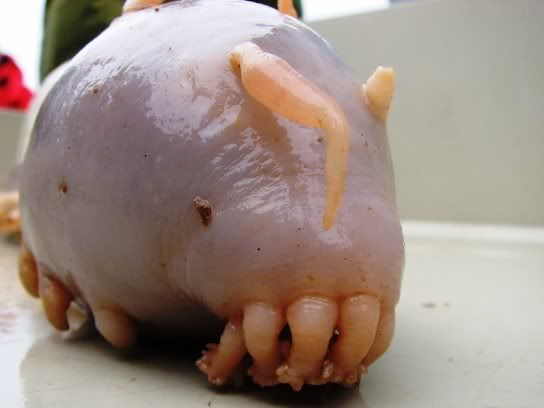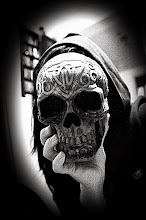For marine biologist, the sea pig goes under the name Scrotoplanes. They feed on things found in the mud of the deep sea floor by using the tentacles to scope it in. Sea pigs live on or underneith the surface of the bottom. I don't know if the position is decided by the species or if all species can live both ways (maybe someone else knows?). Beauty is said to be in the eye of the beholder, but I can't seem to make up my mind on whether or not I'd like the appearance of the Scrotoplanes or if I'm just overwhelmed by unpleasant feelings. As one of my friends stated when I presented her a picture, "I am happy yet disgusted at the same time". They're cute, but ugly. They make you wanna cuddle them followed by shrieking in horror when you feel their cold (at least I imagine them as being cold) movement on your palm. They invoke very opposing feelings indeed...
 Scrotplanes belong to the phylum Echinoderms, which includes other sea floor creatures such as sea stars, sea urchins and sea cucumbers. In the phylum, they are further classified as Holothuroidea, which states that they are more related to the sea-cucumbers than the other members of this phylum. Together they form large groups on the sea floor, making their way in a sludge-like fashion. Movement is generated by using long tube feet. I don't know if these feet is what can be seen on the picture on the left, or if those feet-like thingies are just some tentacles or confusing ornaments of unknown purpose.
Scrotplanes belong to the phylum Echinoderms, which includes other sea floor creatures such as sea stars, sea urchins and sea cucumbers. In the phylum, they are further classified as Holothuroidea, which states that they are more related to the sea-cucumbers than the other members of this phylum. Together they form large groups on the sea floor, making their way in a sludge-like fashion. Movement is generated by using long tube feet. I don't know if these feet is what can be seen on the picture on the left, or if those feet-like thingies are just some tentacles or confusing ornaments of unknown purpose.(Image revised from http://www.mbari.org/benthic/holothurians.html)
Sources:
http://en.wikipedia.org/wiki/Scotoplanes
http://animals.jrank.org/pages/1631/Sea-Cucumbers-Holothuroidea-SEA-PIG-Scotoplanes-globosa-SPECIES-ACCOUNTS.html



Inga kommentarer:
Skicka en kommentar